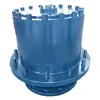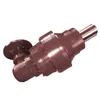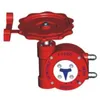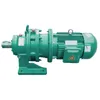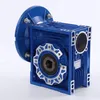Gearbox & reducers are mechanical devices used to control speed and torque in machinery. They are essential in various industries, including automotive, manufacturing, and robotics. By reducing speed and increasing torque, they ensure efficient power transmission and operational reliability.
Understanding the technical specifications is crucial for selecting the right gearbox or reducer. Below is a detailed table of common parameters:
| Parameter | Description | Typical Range |
|---|---|---|
| Ratio | The reduction ratio between input and output speed. | 5:1 to 100:1 |
| Torque Capacity | Maximum torque the gearbox can handle without failure. | 10 Nm to 10,000 Nm |
| Efficiency | Percentage of input power delivered to the output. | 85% to 98% |
| Input Speed | Maximum rotational speed at the input shaft. | 500 to 3000 RPM |
| Backlash | The clearance between mating gear teeth. | 1 to 20 arc-min |
| Mounting Configuration | How the gearbox is attached to the machinery. | Foot-mounted, flange-mounted, or shaft-mounted |
| Weight | Mass of the gearbox unit. | 1 kg to 500 kg |
| IP Rating | Ingress Protection rating for dust and water resistance. | IP54 to IP67 |
What is the main function of a gearbox or reducer?
The primary function is to modify the speed and torque from a power source, such as an electric motor, to match the requirements of the driven equipment, ensuring optimal performance and energy efficiency.
How do I choose the right gearbox for my application?
Consider factors like required torque, speed ratio, efficiency, operating environment (e.g., temperature, exposure to elements), mounting options, and backlash tolerances. Consulting technical datasheets and engineering support is recommended.
What maintenance is required for gearbox & reducers?
Regular maintenance includes lubricating gears, checking for wear and tear, monitoring noise and vibration levels, and ensuring proper alignment. Sealed units may require less frequent maintenance but should still be inspected periodically.
Can gearbox & reducers be customized?
Yes, many manufacturers offer customization options for ratios, materials, shaft configurations, and mounting styles to meet specific application needs. Custom designs may involve additional lead time and cost.
What are the signs of gearbox failure?
Common signs include unusual noises (e.g., grinding or whining), overheating, oil leaks, increased backlash, and decreased efficiency. Early detection and repair can prevent catastrophic failure.
How does backlash affect performance?
Backlash can cause positional inaccuracies, vibration, and reduced efficiency in precision applications. Minimizing backlash is critical in robotics and CNC machinery where high accuracy is required.
Are there environmentally friendly gearbox options?
Yes, options include units designed with energy-efficient gearing, biodegradable lubricants, and materials that comply with environmental regulations. Selecting high-efficiency models can also reduce energy consumption.
What is the difference between a gearbox and a reducer?
While often used interchangeably, a reducer specifically refers to a device that reduces speed and increases torque, whereas a gearbox can refer to any system of gears that transmits power, including those that increase speed or change direction.
